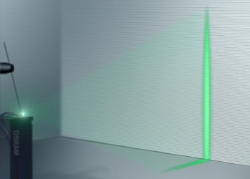OSRAM Opto Semiconductors has achieved a major breakthrough in the laboratory with its direct emitting green indium-gallium-nitride laser. It already achieves an optical output of 50 mW and emits light in true green with a wavelength of 515 nm. Compared with semiconductor lasers based on current technology that operate with frequency doubling, direct emitting green lasers are more compact, offer greater temperature stability, are easier to control and have higher modulation capability.
 Straight from the laboratory: With its direct emitting green laser OSRAM Opto Semiconductors has set an important new milestone in mobile laser projection.
Straight from the laboratory: With its direct emitting green laser OSRAM Opto Semiconductors has set an important new milestone in mobile laser projection.
OSRAM Opto Semiconductors has overcome the previous limits of the InGaN material system. At the pre-development stage, the company succeeded in manufacturing the first direct emitting green laser diode from the InGaN (indium-gallium-nitride) material system with a high optical output. The diode emits a “true green”, which is defined by the spectral range of 515 to 535 nm. In this range, efficient high-quality semiconductor lasers have been commercially available only as frequency-doubled versions. In the medium term, however, direct emitting green lasers could replace frequency-doubled lasers for numerous applications. They are easier to control, and also offer greater temperature stability, a smaller form factor and higher modulation capability at several 100 MHz.
Preliminary performance data are impressive. In pulsed mode at room temperature the laboratory prototype has achieved an optical output of 50 mW; the threshold current density is around 9 kA/cm². Dr. Christian Fricke, Chief Technology Officer at OSRAM Opto Semiconductors, said: “With this demonstrator we have shown that green lasers can be manufactured from indium-gallium-nitride. We are therefore on course to produce compact, cost-effective, high-quality green laser light sources.“ Green lasers are used in numerous medical and industrial applications, but also as light sources in mobile mini-projectors. A direct emitting green laser can help make these projectors even smaller with even better performance. OSRAM Opto Semiconductors already offers blue emitting InGaN laser diodes for commercial applications.
German Ministry for Education and Research is sponsoring the MOLAS research project (until March 2011, FKZ 13N9373) which involves technologies for ultra-compact and mobile laser projection systems. The great advantage of laser projectors – a consistently sharp, true-color, high-contrast image irrespective of the projection distance and projection surface – should one day be available also to users of cell phones and cameras. As part of this project, OSRAM is developing efficient laser light sources based on the InGaN material system (indium-gallium-nitride) for mobile projection systems. With the first direct emitting green laser the company has achieved an important early objective.